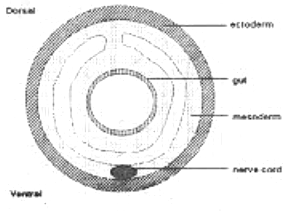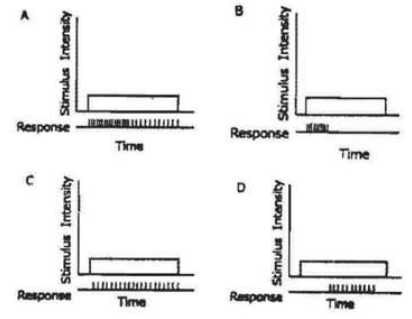 Multiple Choice Questions
Multiple Choice QuestionsIn which of the following classes of vertebrates there are groups of animals without limbs?
Fish, reptiles and mammals
Reptiles only
Reptiles and amphibians
Amphibians only
The schematic section given below of an animal indicates that the animal is:

Triploblastic, coelomic, invertebrate
Triploblastic, acoelomic, invertebrate
Diploblastic, coelomic, invertebrate
Triploblastic, coelomic, vertebrate
Cladistic classification is based on
sequential order in which branches arise from a phylogenetic tree
the order of sequence divergence
morphological features and skeleton of individuals
cellular organization and cytoskeleton
Tautonym is an informal taxonomic designation used for animals referring to
same name for genus and species
same name for species and subspecies
trinomial nomenclature
the name of the author for the species
A marine biologist dug up a small animal from the ocean floor. The animal was uniformly segmented with short, stiff appendages and soft, flexible skin. It had a complete digestive system and an open circulatory system but no exoskeleton. Based on this description, the animal appears to be a
lancelet
roundworm
mollusc
crustacean
Which of these programs is used to conserve a species facing extinction?
Captive breeding
Natural resources
Sustainable use
Edge effects
The following table gives vascular tissue characteristics of four divisions of Tracheophyta.
| Divisions | Vascular tissue characteristics |
| A. Psilophyta | i. Well-developed tracheid and pits in lateral wall |
| B. Lycopodiophyta | ii. Tracheids |
| C. Sphenophyta | iii. Tracheids, vessels and well-developed phloem |
| D. Pteridophyta | iv. Primitive tracheids and pits in lateral wall |
Identify the correct combinations.
A - i; B- ii; C - iii; D - iv
A - ii; B - i; C - iv; D - iii
A - iv; B - iii; C - ii; D - i
A - iii; B - iv; C - i; D - ii
As per the International Code of Botanical Nomenclature, 2006 (Vienna Code), which of the following is a Nothospecies?
Polypodium vulgare subsp. prionodes (Asch.) Roth.
Polypagon monspeliensis (L). Desf.
Agrostis stolonifera L.
Agrostis stolonifera L. × Polypogon monspeliensis (L.) Desf.
D.
Agrostis stolonifera L. × Polypogon monspeliensis (L.) Desf.
Agrostis stolonifera L. × Polypogon monspeliensis (L.) Desf. is a Nothospecies.
Which of the following groups have only two wings?
Honey bee, beetle, ant
Butterfly, housefly, fruitfly
Dragonfly, butterfly, fruitfly
Housefly, fruitfly, mosquito

Various types of excitability tissues when stimulated showed response as shown in the above figures. Which one of them is an example of fast adapting tissue?
A
B
C
D
